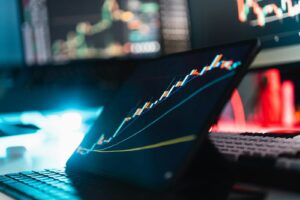Tony Whincup, Head of Investment Specialists at TrinityBridge, unpacks the far-reaching implications of President Trump’s new tariffs on global markets, the risks for asset allocators, and how investors can remain resilient amid rising volatility, policy unpredictability, and economic crosswinds.
What happened?
After a prolonged on-off purgatory, President Trump finally announced tariffs on US imports, starting at a universal 10% minimum and ranging much higher for some countries, with 25% import tax on all cars and auto parts entering the US from early April. Trump is attempting to repatriate jobs and wealth which he believes have effectively been stolen by overseas competitors. The move caused widespread consternation.
Trump believes “a little short-term interruption” outweighs the risks of market and economic turmoil and has effectively staked his presidential legacy on this call. He believes US-produced goods will become relatively cheaper, and make Americans richer, by encouraging more domestic investment and production – creating American jobs.
Many economists doubt the formula the Trump administration used to determine different tariff rates for individual nations. The inclusion of Gibraltar (a UK dependency), Réunion (France) and, bizarrely, the Heard & McDonald Islands (uninhabited outposts in the South Antarctic) in the ‘rate-card’ also questions the regime’s competency. Israel is also an interesting case in point – it dropped all tariffs on the US before the tariff announcement but still received a customised 17% rate.
Market reaction
US equities posted their worst day of losses since the pandemic in 2020, with US markets harder hit than other major indices, though falls were widespread. Falls were also more concentrated in certain sectors, including consumer discretionary. This followed a rocky first quarter – the worst start to a year since 2022. US 10-year bond yields have fallen (prices risen) and are now below 4% as investors seek security. UK 10-year gilt yield moves have been more muted – despite also sharply pulling back, the UK was the best-performing major equity market yesterday. Sterling initially strengthened against the US dollar but has since settled around 1.30.
Despite these falls, markets arguably could well have fallen further, and the only way to rationalise a relatively muted market response to such news (back around the pre-election level on equities and, by some measures, for bonds too) is that investors expect the tariffs to be rolled back. This could indeed be ‘peak tariff’ with walkdowns from here as a) bi-lateral deals are done, and b) a domestic backlash ensues against stock market declines and weaker economic growth in the US. On the other hand, tariffs are a key revenue raising policy tool of this US administration, and countries might negotiate their individual rate lower but perhaps not below the 10% global minimum.
How do tariffs work?
Tariffs are a tax paid by importers on the value of goods at the point of entry, not the point of sale. Domestic costs such as warehousing, supply-chain distribution, staffing and the seller’s profit increase the product’s final sale price. This means that if, for example, a washing machine’s value on arrival at a port is $500 and it eventually sells for $1,000, then a 50% tariff would apply to the $500 import price (giving a $250 import tariff). This is important as there is not a one-for-one pass through of tariffs on the washing machine’s sale price; on lower tariff rates of 10%, the pass-through cost could be more muted than the headline number.
Tariffs may be inflationary in several ways as the cost is likely to be passed onto consumers: foreign goods become more expensive and face a further barrier to make it to the US market; US firms face less competition and may view tariffs as a foil to raise prices themselves; and, if sustained, workers may demand higher wages in response to higher prices.
Otherwise highly efficient supply chains will be disrupted globally. US companies are not immune.
What we don’t know
We are entering a period of considerable uncertainty. It is not yet possible to determine the degree to which companies will pass on the cost of tariffs to the consumer; be able to re-jig supply chains, or substitute components and parts to minimise the impact; or how the relative valuation of different currencies will move and affect the cost of importation. It is also currently unclear whether other countries will retaliate directly (you’ll do 20%, we’ll do 20%) or indirectly – by, for example, creating other policy barriers to the export of intellectual property, or preventing US companies from operating in certain fields altogether.
Will these tariffs put a floor under the investment risk – a clearing event after which companies and investors can assess their impact and move on? Will they stick or will there be carve-outs, exemptions and reprieves? What’s in the price? Investors are clearly cautious. These tariffs erode confidence and trust and could have long[1]term economic costs. US voters won’t be able to have another say until the mid-term elections in September 2026.
Overall, these tariffs are bad for investor confidence. The optimistic case is that this point marks ‘peak tariff’, and everything from here is better than feared; or if the damage done spooks central banks to reduce interest rates quicker, easing credit conditions in the private sector where greater activity might offset some of the negative impact tariffs will likely cause. All of this is unknown.
The bigger picture
Trump’s position on tariffs – and White House policy uncertainty – compounds two other key issues.
First, that US interest rates are arguably restrictively high and causing a ‘growth scare’. The few interest rate cuts the US Federal Reserve (Fed) has delivered since last September have not yet fed through to lowering real long-term borrowing costs for the US consumer, such as on 30-year mortgages. The Fed has the unenviable task of seeing how Trump’s policies impact data read-outs. While it awaits confirmation, the hiatus may jeopardise a ‘soft-landing’ scenario for the US economy in which growth and inflation moderate without significant job losses, and consumers are resilient and confident enough to keep spending. Companies may defer or cancel their plans to invest amidst uncertainty, which in turn could derail growth.
US immigration policy further complicates the picture. All things equal, a bigger population means more growth (if not more growth-per-capita) and so effectively shutting the border with Mexico may cause a labour shortage which could stimulate inflation in a more sustained way than higher tariffs – which may prove to be a one-time jump in prices.
Second, the recent unwinding of elevated valuations for some Artificial-Intelligence (AI) related companies has developed into a determined headwind. Investors are fretting about the enormous capital outlay of companies in this field and wondering who will best monetise the long-term AI opportunity. All things equal, the risks of a US recession this year have increased. There is also a question mark over other regional economies.
All things equal, the risks of a US recession this year have increased. There is also a question mark over other regional economies.
What does this mean for the UK?
Tariffs are inflationary. Trump’s policies will therefore have a direct influence on the pace and quantum of future interest rate cuts in the US. As the Fed sets the tone for interest rates globally, the Bank of England (BoE) may find its domestic mandate of stabilising the economy, employment and prices buffeted by forces beyond its control. The BoE may have to deal with lower growth and higher inflation and set its interest rates accordingly. This is a horrible mix for Chancellor Reeves whose financial forecasts leave hardly any headroom for manoeuvre ahead of the next Autumn Budget.
Perhaps the UK got off relatively lightly on tariffs as it has a trade surplus with the US; or perhaps it’s a fluke of Brexit that the UK has avoided the European Union’s 20% flat rate. Prime Minister Keir Starmer has for some time signalled that the UK could do a deal – but whether accepting chlorine-washed chicken and the like from the US would be enough to trade-away these tariffs is unclear.
On asset allocation considerations
Depending on the mandate, investment and fund managers have been assessing opportunity, risk and reward at the portfolio level. We have been aware for some months that US growth is decelerating and have been minded to pare back our equity allocations, trimming equities into rallies, looking for less market sensitive and more defensive companies, whilst still maintaining adequate exposure to long-term structural trends. Stock selection is critical.
In bonds, for some time we have generally preferred UK government gilts to corporate bonds. Gilts are high quality and currently offer decent starting yields around 4.5%; they should act as a shock-absorber within portfolios in the event of a downturn. As the risk of a recession mounts, corporate bond exposure is generally limited to investment grade and short-dated maturities – good yields can be had here too by managing the risks sensibly.
Where appropriate, we are complementing this equity and fixed income positioning with suitable alternatives, such as physical gold and infrastructure securities. Apart from considering the relative correlation to equities or bonds, certain alternatives can also provide both inflation-protection and the ability to reward investors in different market outcomes.
Cash provides some optionality to act quickly and can be a buffer against downturns, but we are mindful that with inflation still relatively high, in real terms its value can quickly diminish. Beyond immediate or short-term needs, cash cannot deliver the growth, income and inflation protection our clients seek.
In conclusion
There’s no doubt that these tariffs pose far-reaching questions about the globalised free[1]trading world largely in place since the 1980s which for many countries – the US included – has delivered relative prosperity and stability. For many companies, tariffs pose serious questions. But President Trump is unpredictable and transactional, and this is far from the end of the current drama – whether through de-escalation, negotiation or political impasse (as the US electorate next votes in the September 2026 mid-terms). Company management teams have also proven time and again that they can adapt to change and still profit.
Perspective is key. It is as hard today to see a way through as it perhaps was during the pandemic of 2020, the eurozone debt crisis of 2012, and the global financial crisis of 2008. But there was a way through, and longer-term gains were had each time.
Staying focused
Now more than ever is a time to remain focused. It may be tempting to react to every tweet but in doing so, lose sight of the bigger picture. A powerful confluence of factors is at play, and we believe investors will be best served by doubling[1]down on tried and tested methods to navigate a way through: time in the market, not timing the market, diversification and sticking to a long-term plan.
Our investment team remains laser-focused on fundamental analysis and diversification and will continue to assess economic data and company fundamentals to select what we believe offer the best risk-reward pay off for our clients.















